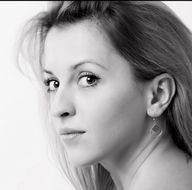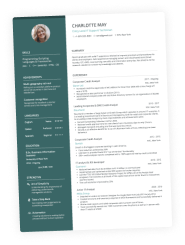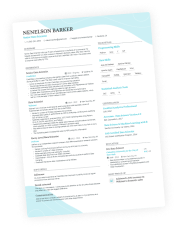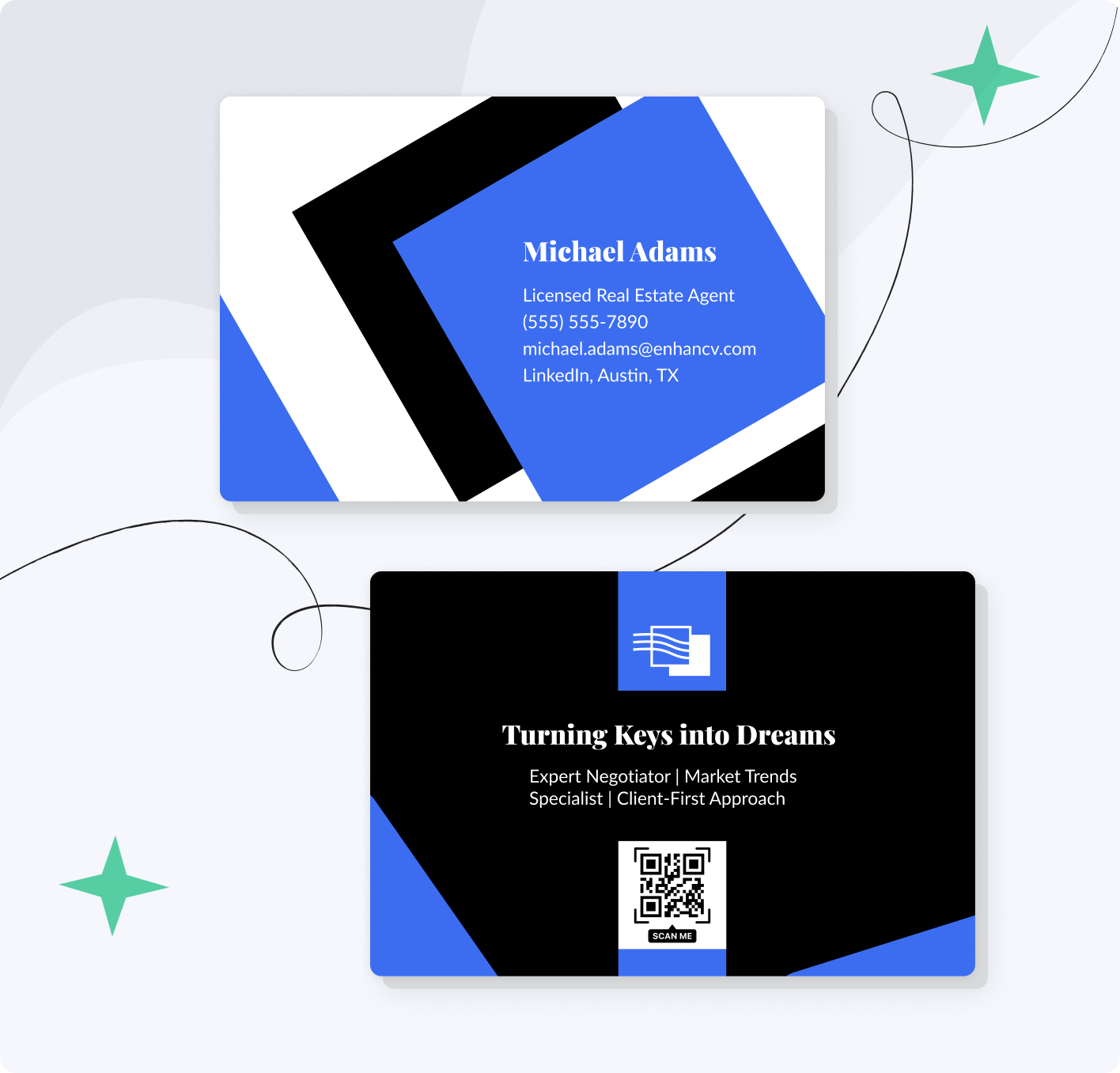If you’ve just walked out of a career fair with a stack of business cards and a head full of possibilities, here’s your next move: send a follow-up email, fast. For college students, recent grads, and early-career pros, this is your chance to make an impression, remind recruiters who you are, and turn a conversation into an opportunity.
However, it’s essential to make your message neat, clear, and easy to respond to.
That’s where Enhancv’s resume and expert-backed templates come in—designed to help you write emails that get opened, read, and answered.
Let’s get yours ready.
Key takeaways
- Send your follow-up email within 24 hours to stay top of mind with recruiters.
- Personalize your message by referencing the career fair and your conversation with the recruiter.
- Keep your email short, professional, and action-oriented—aim for up to 200 words.
- Always include your resume, LinkedIn profile link, and a clear call to action.
- Adapt your tone based on the company type, but when in doubt, lean toward professional and courteous.
Why you should send a follow-up email after a career fair
Most candidates leave a career fair hoping the conversation they had will stick. But hoping isn’t a strategy. Following up is. A well-timed email helps you stand out and keeps your name top of mind when recruiters sift through stacks of resumes.
The thank-you gap
Harvard Business Review reports that while just 25% of candidates follow up with a thank-you message after an interview, 80% of hiring managers find those messages valuable when making their final decisions.
A follow-up email is also a great chance to reinforce your personal brand. Include a link to your updated LinkedIn profile to give recruiters a richer sense of who you are and where you’re headed.
Did you know you can turn your resume into a business card with a QR code? It's a practical, standout way to show professionalism and makes it easy for recruiters to access your profile or portfolio on the spot. You’ll find an example below.
More reasons to write a follow-up email after a career fair
- Differentiate yourself from other candidates:Plenty of job seekers show up at a job fair. Far fewer take the initiative to follow up. A short, thoughtful email signals drive, attention to detail, and genuine interest—qualities employers look for.
- Show professionalism and interest:Following up demonstrates that you understand professional etiquette. It tells recruiters you respect their time and value the connection you made.
- Reinforce personal connection: A follow-up email lets you remind the company representative of your conversation — especially useful when they’ve met dozens of candidates in a single day. Referencing specifics from your chat helps you stand out and feel more memorable.
- Increase your chances of an interview: Hiring decisions often come down to subtle factors like follow-through. A prompt, professional email can tip the scales in your favor and open the door to an interview.
Sending a follow-up email is only effective if it reaches the recruiter while the conversation is still fresh.
Here’s when to hit “Send” for the best impact.
When to send the follow-up email
Timing matters more than most people realize. Send your email within 24 hours of the career fair, while the recruiter still remembers your conversation. If you wait too long, your message risks being lost the noise or arriving after decisions have already been made.
If you met multiple recruiters, prioritize the ones you most want to work with and follow up first. And if you promised to send supplemental materials (like a resume, portfolio, or references), this is your moment to deliver—quickly and professionally.
You might have heard that it’s best to wait up to five business days before following up after an interview. But… you haven’t had an interview yet. This was a personal encounter, not a formal screening. You should act fast and send your resume while the conversation is still fresh in the recruiter’s mind.
Psychologically, we tend to remember recent, emotionally engaging interactions more vividly, so the sooner you follow up, the more likely the recruiter is to recall your conversation and associate it with positive intent.
Author’s take
How to write an effective follow-up email after a career fair
A great follow-up email doesn’t have to be long or complex, but it does need to be intentional.
Here’s a quick template for those in a hurry:
Thank-you email template after a career fair
Subject: Great to meet you at the [Event Name]
Dear [Recruiter’s Name],
Thank you for taking the time to speak with me at the [Career Fair Name]. I enjoyed learning more about [Company Name] and the work your team is doing.
I’m very interested in [mention the specific role or area] and believe my background in [your field or key skill] would be a strong match. Please find my resume attached, along with a link to my LinkedIn profile: [LinkedIn URL].
I’d love the opportunity to stay in touch and explore how I might contribute to your team.
Best regards,
[Your Name]
[Phone Number]
Now, let’s get into the details of how to structure yours so it gets noticed and drives the next step.
Create a spot-on subject line
Your subject line is what gets your email opened or ignored. Make it specific, personal, and professional, so it stands out in a crowded inbox and immediately signals relevance.
Here are three ways to do it better:
- Avoid generic phrases like "Following Up" or "Checking In." They fade into the background and give the recruiter no context. Instead, make your subject line descriptive and personalized.
- Mention where you met. This gives the recruiter instant context and helps them mentally connect your email with the face-to-face interaction. For example, "Great speaking with you at the Chicago Tech Career Fair."
- State your purpose. If possible, mention the role or type of opportunity you’re interested in—this primes the recruiter for why you’re following up. Try "Following up on Marketing Intern role — Boston University Career Expo."
Subject line do’s and don’ts
| DO | DON’T |
|---|---|
| Mention the career fair name or location. | Use vague phrases like “Following Up” or “Checking In.” |
| Reference your conversation or the role you discussed. | Leave out context—“Thanks again” won’t jog their memory. |
| Keep it professional and direct. | Use overly casual language like “Hey!” or “Just saying hi.” |
| Show intent—signal interest in a next step. | Be passive or use subject lines that sound like an afterthought. |
If you had a standout conversation or made a personal connection, referencing that in the subject line can give your email an even stronger chance of getting opened.
Example subject lines
- Re: Great to meet you at the Chicago Tech Career Fair
- Following up on our chat at the Boston University Career Expo
- Thank you for your time at the Austin Job Fair — Marketing Intern Opportunity
- Nice speaking with you at the NYC Career Fair — Interested in Sales Role
- Following up on our chat at the NYC Design Expo — Graphic Design Internship
- Thank you for your time at the Chicago Tech Career Fair — Software Engineer Opportunity
Structure the email body
Think of your follow-up email as a simple conversation recap—not a full cover letter.
Here’s a clear flow to follow when writing it:
- Address the recruiter by name: Personalize your greeting and use the recruiter’s name (double-check spelling!). This small detail helps your message feel genuine and shows you were attentive during your interaction.
- Thank the recruiter for their time: Acknowledge their time and the value of your conversation—this shows professionalism and appreciation.
- Mention the specific event: Name the career fair clearly so the recruiter can place you and recall your interaction.
- Recap your value proposition: Briefly remind them who you are and what you bring to the table. Highlight one or two relevant skills or achievements that align with the company’s needs.
- Express interest in a specific position: If you discussed a particular role, mention it directly. If not, express your enthusiasm for opportunities within the company and suggest where you could add value.
- Include a clear call to action: Politely state what you’d like to happen next—whether that’s an interview, a further conversation, or more information about potential openings.
Example email body
Dear Ms. Taylor,
Thank you again for taking the time to speak with me at the Pacific Northwest Engineering & Tech Career Expo this week. I really appreciated learning more about your team’s work at InnovateAI and your insights on upcoming projects.
As a recent Computer Science graduate with a strong background in machine learning and data visualization, I’m excited about the opportunity to contribute to your product team. During our chat, we discussed the Junior Data Scientist position and I believe my recent internship at DataWorks and hands-on experience with Python and Tableau would be a great fit for the role.
I’d love the opportunity to discuss the position further and explore how I can support your team’s goals. Please find my resume and portfolio attached. Looking forward to staying in touch.
Best regards,
Alex Morgan
PRO TIP
Most recruiters will read your follow-up on their phone, so make it mobile-friendly:
- Keep subject lines under 50 characters so they don’t get cut off.
- Lead with your most important info in the first 1–2 lines—that’s what shows up in mobile previews.
- Use short paragraphs and white space to make your message easy to scan on the go.
- Skip fancy formatting and avoid odd file types for attachments. Stick to clean PDFs and standard links.
End the email right
How you close your email matters—it’s your last impression. The same principles apply here as when ending a cover letter or a quick e-note: keep it short, clear, and professional.
Here’s what you can include:
- Attach your resume (and portfolio, if relevant): Make it easy for the company rep to revisit your credentials without digging through old files.
- Re-share your LinkedIn profile link: This reinforces your professional brand and provides an easy path to learn more about you.
- Add a professional signature with your full contact details: Include your name, email, phone number, and LinkedIn URL. No need for flashy quotes or graphics—keep it clean and straightforward.
Your tone matters just as much as your message.
Here's how to strike the right balance:
Style and tone tips for career fair follow-up emails
- Keep it brief and to the point: Aim for 150–200 words max. Focus on the essentials that reinforce your interest, fit, and next steps—no need to retell your entire resume.
- Use a professional and respectful tone: Be warm and approachable, but not overly casual. Always proofread carefully—typos and slang can undermine the impression you’ve worked hard to make.
- Adapt your tone to the company type: For corporate or government roles, stick with a more formal, structured tone. For startups, you can lean slightly more casual, while still professional. And when writing to creative agencies, it’s okay to let a bit more of your personality shine through, just ensure it aligns with the brand and culture.
Now that you know how to structure your follow-up thank-you email, let’s make it even easier.
Below you’ll find practical templates for different scenarios—whether you’re applying for an internship, reinforcing a personal connection, or reaching out via LinkedIn. Use these as a starting point, then tailor them to reflect your voice and the conversation you had.
7 examples and templates for different scenarios
No matter where you are in your career, sending the right follow-up message can help you move forward. The key is to tailor your message to your experience and goals.
Here are seven follow-up email templates designed for different types of career fair attendees.
#1. Follow-up email for college students and recent graduates
If you’re a student or recent grad, your follow-up email is your chance to turn a brief conversation into an opportunity. This template helps you sound professional, highlight your potential, and express interest, even if your work experience is still limited.
Subject: Thank you for your time at the [Career Fair Name]
Dear [Recruiter Name],
Thank you again for taking the time to speak with me at the [Career Fair Name]. I enjoyed learning more about [Company Name] and the exciting projects your team is working on.
As a recent [Your Major] graduate with hands-on experience in [Relevant Skill/Project], I’m very interested in the [Position Name] we discussed. I believe my [Skill/Experience] would contribute well to your team.
I’d love the opportunity to explore this role further. Please find my resume attached and my LinkedIn profile here: [LinkedIn URL]. Looking forward to staying in touch.
Best regards,
[Your Name]
#2. Follow-up email for early-career professionals
Early-career professionals often attend job fairs to explore new opportunities or pivot to different roles. This template helps you spotlight your growing expertise and communicate clear intent for your next career move.
Subject: Following up on our conversation at the [Career Fair Name]
Dear [Recruiter Name],
Thank you again for speaking with me at the [Career Fair Name]. I appreciated your insights about [Company Name] and the direction your team is heading.
With two years of experience in [Your Field], including recent work on [Relevant Project/Experience], I’m very interested in the [Position Name] we discussed. I’m confident my background in [Skill/Experience] can contribute to your goals.
I would welcome the opportunity to continue our conversation. Please find my resume attached and portfolio here: [portfolio URL].
Kind regards,
[Your Name]
#3. Follow-up email leveraging a personal connection
Networking can go a long way, and sometimes a shared connection can help reinforce your message. The follow-up email below is great for any attendee (student, recent grad, or professional) who discovers a mutual contact with the recruiter or company.
Subject: Thank you for your time at the [Career Fair Name]
Dear [Recruiter Name],
Thank you again for taking the time to speak with me at the [Career Fair Name]. After our conversation, I realized we have a mutual connection — [Mutual Contact Name], who spoke highly of you and your work.
As I mentioned, I’m very interested in opportunities at [Company Name]. With my background in [Relevant Experience/Skill], I believe I can contribute meaningfully to your team.
I’d love to explore next steps and discuss how I can support your goals. Please find my resume attached and my LinkedIn profile here: [LinkedIn URL].
Warm regards,
[Your Name]
#4. LinkedIn follow-up message (for all groups)
Many recruiters appreciate a quick, professional follow-up on LinkedIn—especially if you had a meaningful conversation but didn’t exchange emails. This template works for any type of attendee and is especially useful for those entering fast-moving industries like tech, marketing, or startups.
No subject line option on LinkedIN
Hi [Recruiter Name],
Thank you again for taking the time to speak with me at the [Career Fair Name]. I really enjoyed learning more about [Company Name] and the opportunities on your team.
I’m very interested in the [Position Name] we discussed and would love the chance to contribute. Please feel free to review my profile and recent work here. Looking forward to staying connected!
Best,
[Your Name]
#5. Follow-up email after a group booth or a panel conversation
If you attended a panel or spoke to a recruiter at a crowded booth, your email needs to help them remember you and your interest. The template below helps summarize your key points and keep the conversation going, even if the interaction was brief.
Subject: Great to meet you at the [Career Fair Name]
Dear [Recruiter Name],
It was great meeting you during the [Career Fair Name]. I enjoyed hearing your insights on career growth at [Company Name] and the team culture you described.
I’m very interested in opportunities within your organization, particularly in [Position or Team]. With my background in [Relevant Experience/Skill], I’d love the chance to contribute and grow with your team.
Please find my resume attached and LinkedIn profile here: [LinkedIn URL]. I look forward to staying in touch.
Best regards,
[Your Name]
#6. Follow-up email for military veterans transitioning to civilian careers
Military veterans often attend dedicated career fairs to explore opportunities in the civilian workforce. A well-crafted follow-up email can help bridge that transition and highlight the valuable skills you acquired during your service.
Subject: Thank you for your time at the [Career Fair Name]
Dear [Recruiter Name],
Thank you for speaking with me at the [Career Fair Name]. I appreciated the opportunity to learn more about [Company Name] and the ways veterans can contribute to your mission.
With [X years] of military service in [Branch], where I developed strong skills in [Leadership, Project Management, Teamwork, Logistics — customize], I’m now pursuing civilian career opportunities in [Industry or Role]. I’m particularly interested in the [Position Name] we discussed and believe my background can bring value to your team.
Please find my resume attached and my LinkedIn profile here: [LinkedIn URL]. I’d welcome the opportunity to discuss next steps and explore how I can contribute.
Best regards,
[Your Name]
#7. Follow-up email for vocational/trade students
Students in vocational programs or skilled trades often attend career fairs looking for apprenticeships or direct-hire opportunities. The email example below helps communicate professionalism and practical skills—even if you don’t have a traditional resume.
Subject: Nice speaking with you at the [Career Fair Name]
Dear [Recruiter Name],
Thank you for speaking with me at the [Career Fair Name]. I appreciated learning about opportunities at [Company Name], especially within your [Specific Department or Role].
I’m currently completing my [Vocational Program/Certification] in [Field], with hands-on training in [Relevant Skill]. I’m very interested in pursuing an apprenticeship or direct hire opportunity with your team.
Please find my resume attached. I’d be excited to discuss how I can contribute to your projects. Looking forward to connecting further.
Best regards,
[Your Name]
Best practices for sending a career fair follow-up email
Before you hit send, here are a few tips to keep in mind. These small details can make a big difference in how your email is received and whether it leads to a next step.
- Personalize each email: Reference the specific career fair, the conversation you had, or a topic that stood out—this shows you’re genuinely interested.
- Address the recruiter by name: If you didn’t catch it, check their business card, company’s website, or LinkedIn.
- Keep it brief and focused: Aim for 150–200 words. Your goal is to reinforce interest and prompt a reply, not retell your entire background.
- Maintain a professional tone: Warm and approachable is good, but avoid casual slang or overly familiar language.
- Proofread carefully: Typos or grammatical errors can raise some red flags.
Include relevant attachments and links: Always attach your resume and, if appropriate, a portfolio. Add your LinkedIn profile link to strengthen your personal brand.
End with a clear call to action: Politely indicate what you’d like to happen next—whether that’s an interview, further conversation, or more information. - If you don’t hear back: You can do a second follow-up after five to seven business days and reiterate your interest. Briefly restate your value, and ask if there’s any update or additional information you can provide. Even a short check-in shows persistence without being pushy.
Common mistakes to avoid
- Misspelling the recruiter’s name: Nothing says “I wasn’t paying attention” like getting someone’s name wrong. Always double-check.
- Using a vague or generic subject line: Subject lines like “Following up” don’t stand out—be specific about the event or role.
- Forgetting to attach your resume: If you mention it in the email but forget to include it, it weakens your professionalism.
- Sounding too casual or too formal: Find the middle ground—warm and professional is your safest bet.
- Copy-pasting the same email to multiple recruiters: Recruiters can spot this instantly, and it shows a lack of genuine interest.
- Writing a long-winded email: Keep it concise—aim for 150–200 words max to respect their time.
- Leaving out a call to action: If you don’t ask for next steps (a meeting, a reply, more info), you miss the opportunity to move things forward.
- Overloading the email with formatting or jargon: Stick to plain, easy-to-read language—especially on mobile.
- Following up too late: Waiting more than a few days weakens the impact—aim for 24 hours.
Conclusion
A career fair follow-up email is a strategic step that can open real opportunities. With a thoughtful, well-timed message, you show professionalism, reinforce your strengths, and position yourself as someone worth remembering. And with the right tools and templates, crafting an email that gets replies becomes not just easier, but second nature.
Make one that's truly you.




